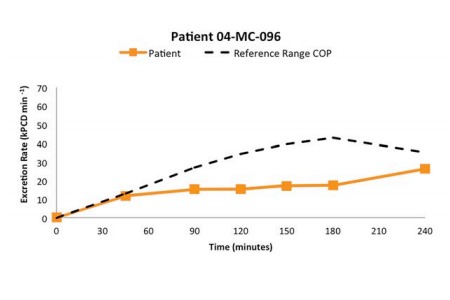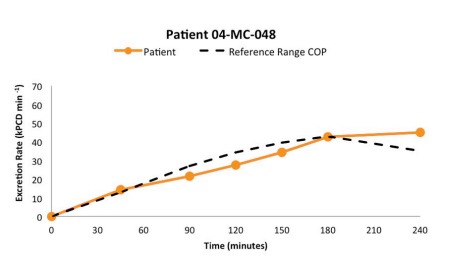The patient’s 13CO2 excretion rate at any measurement time “t” is calculated and reported using the GEBT metric “kPCD.” The acronym kPCD stands for “1000 X Percent Carbon-13 Dose (PCD) excreted per minute.” A kPCD value is calculated at each GEBT measurement time. Calculations incorporate the patient’s gender, age, height and weight.
INTERPRETATION OF GEBT EXCRETION CURVES
A. kPCD Values:
At any measurement time t, the kPCD value (13CO2 excretion rate) is proportional to the rate of gastric emptying. Increasing kPCD values represent increasing rates of gastric emptying.
B. Graphical Display of kPCD Values:
The kPCD value (13CO2 excretion rate) is calculated for each of the patient’s breath collection time points. The values are tabulated and reported relative to time-specific cutoff points (COPs). A plot of the patient’s kPCD values vs. time is graphically displayed.
C. Interpretation of Graphical Display:
1. Subjects with NORMAL rates of gastric emptying typically display values that exceed time-specific COPs (dashed line), reach a maximum value between 120-180 minutes, and then decline
2. In contrast, subjects with DELAYED rates of gastric emptying typically display values below the COP’s and do not begin to decline due to their delay. They will begin to decline sometime after 4 hours. As a result, their highest value will occur at four hours.
3. Because excretion curves of patients with NORMAL rates of emptying are typically declining at 180 – 240 minutes (as is the reference range derived from healthy subjects) and those of DELAYED patients are still rising at 180 and 240 minutes, kPCD values of MODERATELY DELAYEDpatients (Patient 04-MC-048) may rise through the cutoff points at 180 and 240 minutes. Nevertheless, the continuously rising curve with peak excretion occurring at 240 minutes is indicative of delayed emptying as verified by scintigraphy in the GEBT validation study.



The patient’s 13CO2 excretion rate at any measurement time “t” is calculated and reported using the GEBT metric “kPCD.” The acronym kPCD stands for “1000 X Percent Carbon-13 Dose (PCD) excreted per minute.” A kPCD value is calculated at each GEBT measurement time. Calculations incorporate the patient’s gender, age, height and weight.
INTERPRETATION OF GEBT EXCRETION CURVES
A. kPCD Values:
At any measurement time t, the kPCD value (13CO2 excretion rate) is proportional to the rate of gastric emptying. Increasing kPCD values represent increasing rates of gastric emptying.
B. Graphical Display of kPCD Values:
The kPCD value (13CO2 excretion rate) is calculated for each of the patient’s breath collection time points. The values are tabulated and reported relative to time-specific cutoff points (COPs). A plot of the patient’s kPCD values vs. time is graphically displayed.
C. Interpretation of Graphical Display:

- Subjects with NORMAL rates of gastric emptying typically display values that exceed time-specific COPs (dashed line), reach a maximum value between 120-180 minutes, and then decline.

2. In contrast, subjects with DELAYED rates of gastric emptying typically display values below the COP’s and do not begin to decline due to their delay. They will begin to decline sometime after 4 hours. As a result, their highest kPCD value will occur at four hours

3. Because excretion curves of patients with NORMAL rates of emptying are typically declining at 180 – 240 minutes (as is the reference range derived from healthy subjects) and those of DELAYED patients are still rising at 180 and 240 minutes, kPCD values of MODERATELY DELAYEDpatients (Patient 04-MC-048) may rise through the cutoff points at 180 and 240 minutes. Nevertheless, the continuously rising curve with peak excretion occurring at 240 minutes is indicative of delayed emptying as verified by scintigraphy in the GEBT validation study.
Fill out the form below to start the conversation.




